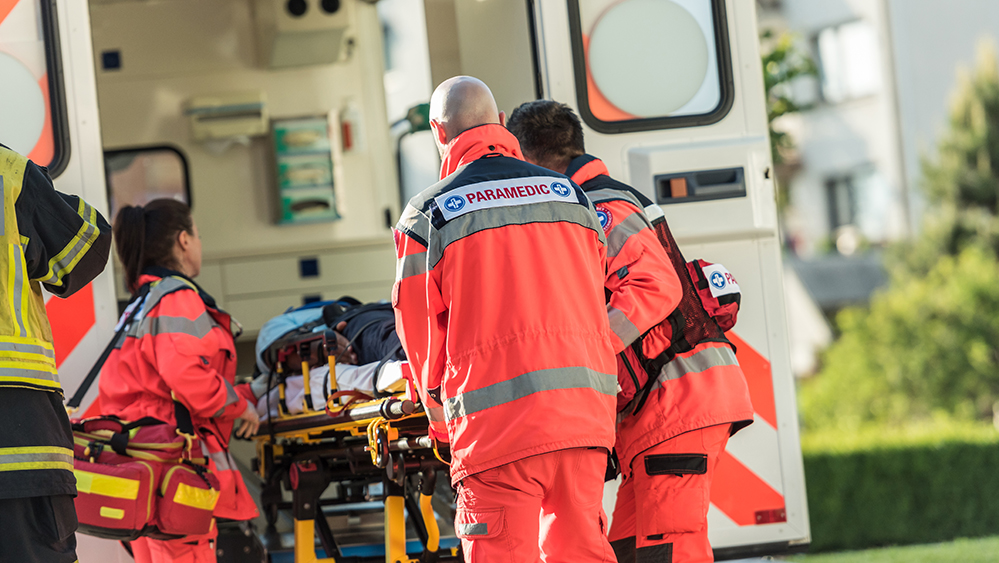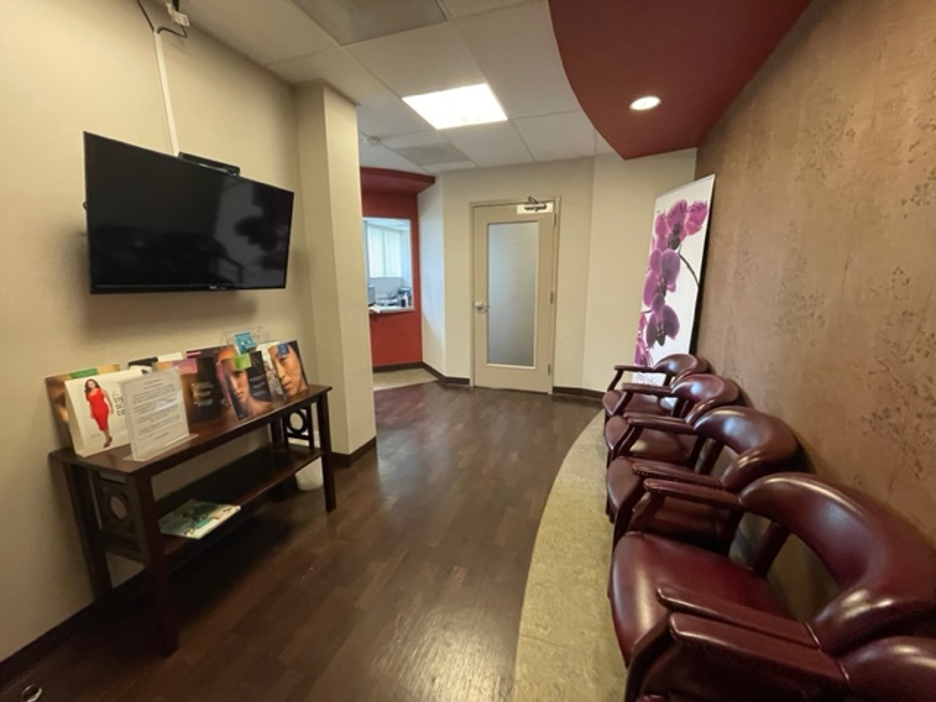Betty’s Life Is Saved with the Inova Stroke Team’s Quick
Coordinated Care
Post date: Feb 21, 2023 | Virginia, US
Editor’s note: Betty was treated at the start of the COVID-19 global health pandemic for a medical emergency – stroke. Today, she is recovered and back home. If you or someone you see is suffering with the signs and symptoms of a stroke, please call 911 or go to the nearest hospital. Fast care within one to three hours is the key to stroke survival.
Seemingly mild symptoms belied a life-threatening stroke – but Inova’s stroke experts got it right.
Betty Sisler loves life’s simple pleasures. She and her husband, Charles, retired Lieutenant “Butch” Sisler of Fairfax County Fire and Rescue, raised one son, and Betty worked as a teacher and an office coordinator in their neighborhood elementary school for more than 20 years. After her career, Betty was enjoying a pleasant retirement in good health, reading, cooking and spending time with Charles. But on a Wednesday in March, that all changed – in the blink of an eye.
A Strange Feeling
Betty and Charles were enjoying their typical weekday morning routine. Betty was working on a crossword puzzle, when suddenly, she began to feel strange. “Things just didn’t feel right in my head,” Betty remembered. Her vision was blurry. She wasn’t experiencing any of the typical stroke symptoms – sudden numbness, weakness, dizziness or confusion – but she told Charles, who was sitting across the room, that something wasn’t right.
Charles, a retired firefighter and first responder, could see that something was wrong with her eyes: when she looked at him, one of her eyes was pointing off to the left rather than straight ahead. Charles was alarmed, so he called 911 right away.
The emergency medical services (EMS) team arrived two minutes later, and the paramedic in charge was concerned about Betty’s condition as well. “The paramedic said, “I don’t like what I’m seeing here. We need to go to Inova Fairfax Hospital,” Charles said. “From that point forward, things began to move in the right direction.” Charles’s quick action in calling 911 – and the EMS team’s quick arrival and transport to Inova Fairfax Hospital – may have saved Betty’s life.
The EMS team also called ahead so that Inova Fairfax Hospital’s stroke team was waiting for them in the ER the minute they pulled in, masked and ready to go. As Charles recalled, the fast actions of Fairfax County Medic Unit 440 and City of Fairfax Engine 403, with three paramedics, helped evaluate Betty. Medic Unit 440 transported her to Inova Fairfax Hospital.
Top Stroke Specialists
The medical team at Inova Fairfax Hospital included vascular neurologist and stroke expert Lexington Culpepper, MD. He said, “When I first saw Betty in the ER, blurred vision was her only symptom. She had none of the typical stroke symptoms: no weakness, no limb incoordination and no slurred speech.” Nevertheless, he saw that her left eye was listing to one side and not moving simultaneously with the right eye, a finding that put Dr. Culpepper on alert. Despite her having virtually no standard stroke symptoms, he was highly suspicious of a specific type of stroke and immediately ordered imaging of Betty’s brain.
At the same time, Betty’s symptoms began to change, now including double vision and vomiting. Imaging confirmed Dr. Culpepper’s suspicion – Betty was in the midst of a particularly rare and dangerous type of stroke, called top of the basilar stroke.
“There was a real possibility of this evolving into something disastrous. People can quickly become comatose and die with a blood clot in this location,” Dr. Culpepper said.
Things began to move even more quickly, as Dr. Culpepper called interventional neuroradiologist Edward Greenberg, MD. “This diagnosis was extremely tricky, but Dr. Culpepper made it quickly. Without the right diagnosis, it doesn’t matter how skilled we are at doing the procedure – we could not have saved her life,” Dr. Greenberg said.
Minimally Invasive Treatment
Dr. Greenberg, who specializes in minimally invasive procedures in the brain, prepared to perform an interventional neuroradiology procedure in the OR that would remove the clot and restore the blood flow in Betty’s brain. The race was on to save Betty’s life – all within an hour of her arrival at Inova Fairfax Hospital.
Dr. Greenberg added, “Fortunately, Dr. Culpepper was right in his assessment so that as a team we were able to act quickly, getting her to the OR so that I could remove the clot.”
In the diagnosis and treatment of strokes, care within one to three hours can mean the difference between life, disability and death.
Looking back today, Charles said, “Everything was so fast. Dr. Greenberg introduced himself and explained the procedure, but you could tell that he wanted to get it done right away. He was gone in a flash.”
Dr. Greenberg performed a mechanical thrombectomy, a minimally invasive procedure that uses thin, flexible tubes called catheters, guided up through the blood vessels from an access point in the groin. Once the catheters reach the brain, tiny suction and retrieval devices are used to dislodge the clot and remove it from the body.
During all of this rapid, life-saving care, Betty remembered, the Inova team displayed the professional excellence and kindness that sets Inova apart. “Everyone was just super – so professional and also caring. The team went beyond the call of duty.”
Charles agreed, “They were so organized. Everyone was doing something, and they all worked as one, coordinated unit. It was phenomenal.”
The procedure was a complete success. “After the procedure, Betty had no focal neurological deficits at all. It’s phenomenal that she has no permanent disability,” Dr. Culpepper said.
Inova’s Stroke Expertise
Each of Inova’s five hospitals is a certified primary stroke center. “In situations such as Betty’s, where time and expertise means the difference between life and death, being treated in a stroke center matters,” Dr. Greenberg said.
No stroke is the same, nor its diagnosis and treatment. It takes fast, coordinated action, from EMS arriving on the scene, to the patient’s arrival at the emergency room, to rapid stroke assessment and imaging, to advanced care from experts in stroke. This can include clot-busting medication as well as surgical intervention, all of which needs to happen immediately, as was true for Betty.
Posterior circulation strokes, like the one Betty had, can be frequently misdiagnosed – with fatal results. For this reason, explained Dr. Culpepper, “It is tremendously important to have a vascular neurologist on site. Vascular neurologists have seen thousands of strokes. Our level of experience benefits the patients who are in the midst of a medical emergency.”
A Happy Ending
With the proper diagnosis and fast care, Betty pulled through. A couple of days later, Betty was back at home and preparing to celebrate her 52-year wedding anniversary with Charles in April – a quiet day spent together. After her ordeal, Betty marveled, “I’m fine. I can speak, my memory is good, I have strength and I can move. It’s phenomenal.”
Charles agreed. “I have her back,” he said.
“It means so much to be back together, doing the things we love to do,” Betty said. “This experience has reminded me to enjoy each day and not to sweat the small stuff so much.”
From the same category
Betty’s Life Is Saved with the Inova Stroke Team’s Quick
Coordinated Care
Post date: Feb 21, 2023 | Virginia, US
Editor’s note: Betty was treated at the start of the COVID-19 global health pandemic for a medical emergency – stroke. Today, she is recovered and back home. If you or someone you see is suffering with the signs and symptoms of a stroke, please call 911 or go to the nearest hospital. Fast care within one to three hours is the key to stroke survival.
Seemingly mild symptoms belied a life-threatening stroke – but Inova’s stroke experts got it right.
Betty Sisler loves life’s simple pleasures. She and her husband, Charles, retired Lieutenant “Butch” Sisler of Fairfax County Fire and Rescue, raised one son, and Betty worked as a teacher and an office coordinator in their neighborhood elementary school for more than 20 years. After her career, Betty was enjoying a pleasant retirement in good health, reading, cooking and spending time with Charles. But on a Wednesday in March, that all changed – in the blink of an eye.
A Strange Feeling
Betty and Charles were enjoying their typical weekday morning routine. Betty was working on a crossword puzzle, when suddenly, she began to feel strange. “Things just didn’t feel right in my head,” Betty remembered. Her vision was blurry. She wasn’t experiencing any of the typical stroke symptoms – sudden numbness, weakness, dizziness or confusion – but she told Charles, who was sitting across the room, that something wasn’t right.
Charles, a retired firefighter and first responder, could see that something was wrong with her eyes: when she looked at him, one of her eyes was pointing off to the left rather than straight ahead. Charles was alarmed, so he called 911 right away.
The emergency medical services (EMS) team arrived two minutes later, and the paramedic in charge was concerned about Betty’s condition as well. “The paramedic said, “I don’t like what I’m seeing here. We need to go to Inova Fairfax Hospital,” Charles said. “From that point forward, things began to move in the right direction.” Charles’s quick action in calling 911 – and the EMS team’s quick arrival and transport to Inova Fairfax Hospital – may have saved Betty’s life.
The EMS team also called ahead so that Inova Fairfax Hospital’s stroke team was waiting for them in the ER the minute they pulled in, masked and ready to go. As Charles recalled, the fast actions of Fairfax County Medic Unit 440 and City of Fairfax Engine 403, with three paramedics, helped evaluate Betty. Medic Unit 440 transported her to Inova Fairfax Hospital.
Top Stroke Specialists
The medical team at Inova Fairfax Hospital included vascular neurologist and stroke expert Lexington Culpepper, MD. He said, “When I first saw Betty in the ER, blurred vision was her only symptom. She had none of the typical stroke symptoms: no weakness, no limb incoordination and no slurred speech.” Nevertheless, he saw that her left eye was listing to one side and not moving simultaneously with the right eye, a finding that put Dr. Culpepper on alert. Despite her having virtually no standard stroke symptoms, he was highly suspicious of a specific type of stroke and immediately ordered imaging of Betty’s brain.
At the same time, Betty’s symptoms began to change, now including double vision and vomiting. Imaging confirmed Dr. Culpepper’s suspicion – Betty was in the midst of a particularly rare and dangerous type of stroke, called top of the basilar stroke.
“There was a real possibility of this evolving into something disastrous. People can quickly become comatose and die with a blood clot in this location,” Dr. Culpepper said.
Things began to move even more quickly, as Dr. Culpepper called interventional neuroradiologist Edward Greenberg, MD. “This diagnosis was extremely tricky, but Dr. Culpepper made it quickly. Without the right diagnosis, it doesn’t matter how skilled we are at doing the procedure – we could not have saved her life,” Dr. Greenberg said.
Minimally Invasive Treatment
Dr. Greenberg, who specializes in minimally invasive procedures in the brain, prepared to perform an interventional neuroradiology procedure in the OR that would remove the clot and restore the blood flow in Betty’s brain. The race was on to save Betty’s life – all within an hour of her arrival at Inova Fairfax Hospital.
Dr. Greenberg added, “Fortunately, Dr. Culpepper was right in his assessment so that as a team we were able to act quickly, getting her to the OR so that I could remove the clot.”
In the diagnosis and treatment of strokes, care within one to three hours can mean the difference between life, disability and death.
Looking back today, Charles said, “Everything was so fast. Dr. Greenberg introduced himself and explained the procedure, but you could tell that he wanted to get it done right away. He was gone in a flash.”
Dr. Greenberg performed a mechanical thrombectomy, a minimally invasive procedure that uses thin, flexible tubes called catheters, guided up through the blood vessels from an access point in the groin. Once the catheters reach the brain, tiny suction and retrieval devices are used to dislodge the clot and remove it from the body.
During all of this rapid, life-saving care, Betty remembered, the Inova team displayed the professional excellence and kindness that sets Inova apart. “Everyone was just super – so professional and also caring. The team went beyond the call of duty.”
Charles agreed, “They were so organized. Everyone was doing something, and they all worked as one, coordinated unit. It was phenomenal.”
The procedure was a complete success. “After the procedure, Betty had no focal neurological deficits at all. It’s phenomenal that she has no permanent disability,” Dr. Culpepper said.
Inova’s Stroke Expertise
Each of Inova’s five hospitals is a certified primary stroke center. “In situations such as Betty’s, where time and expertise means the difference between life and death, being treated in a stroke center matters,” Dr. Greenberg said.
No stroke is the same, nor its diagnosis and treatment. It takes fast, coordinated action, from EMS arriving on the scene, to the patient’s arrival at the emergency room, to rapid stroke assessment and imaging, to advanced care from experts in stroke. This can include clot-busting medication as well as surgical intervention, all of which needs to happen immediately, as was true for Betty.
Posterior circulation strokes, like the one Betty had, can be frequently misdiagnosed – with fatal results. For this reason, explained Dr. Culpepper, “It is tremendously important to have a vascular neurologist on site. Vascular neurologists have seen thousands of strokes. Our level of experience benefits the patients who are in the midst of a medical emergency.”
A Happy Ending
With the proper diagnosis and fast care, Betty pulled through. A couple of days later, Betty was back at home and preparing to celebrate her 52-year wedding anniversary with Charles in April – a quiet day spent together. After her ordeal, Betty marveled, “I’m fine. I can speak, my memory is good, I have strength and I can move. It’s phenomenal.”
Charles agreed. “I have her back,” he said.
“It means so much to be back together, doing the things we love to do,” Betty said. “This experience has reminded me to enjoy each day and not to sweat the small stuff so much.”






